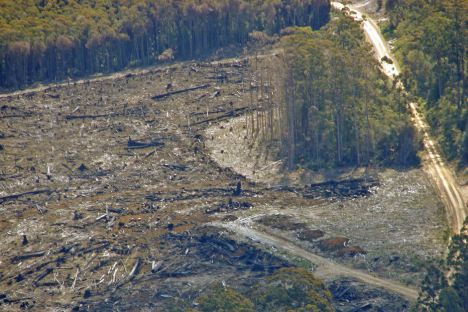Guest Post by Geoff Russell. Geoff is a mathematician and computer programmer and is a member of Animal Liberation SA. He has published a book on diet and science, CSIRO Perfidy.
Back in 2011, the federal Department of Climate Change and Energy Efficiency commissioned the Australian Energy Market Operator (AEMO) to investigate two future scenarios in which the National Electricity Market was fuelled entirely by renewables … as defined by the Department. An essential component of AEMO’s 100 percent renewable solution involves the annual transport of 50 million tonnes of plant material from farms, native forests and plantations in what can only be described as a massive soil mineral mining operation. Log, slash, truck and burn. For details read on.
AEMO has just released draft findings and been met with typically enthusiastic headlines among renewable advocates: “100 percent renewable is feasible: AEMO” and “100% renewables for Australia – not so costly after all”. It took the Financial Review to point out that “not so costly” means doubling the wholesale price of electricity. The AEMO report was welcomed by the Australian Conservation Foundation “100 per cent clean energy on the way”.
Martin Nicholson on BraveNewClimate.com responded quickly saying it’s possible to meet the modelled electricity demand using nuclear power for less than half the lowest cost scenario of the AEMO report. This is $91 billion compared to the range estimate of $219 to $332 billion for 100 percent renewables with Nicholson using the same source of costing estimates as AEMO.
A nuclear solution would also avoid some of the uncosted gotchas, the extra “challenges” contained in the report: land acquisition of half a million hectares, boosting the distribution network, electric vehicle charging infrastructure, biomass logistics infrastructure, and DSP. What’s DSP? … demand side participation. A wonderful piece of euphemistic jargon whereby people either do without or get their electricity at some inconvenient time. E.g., Why cook dinner when you get home from work when you can cook it at lunch time when the solar PV is powering and just re-heat it later? All you need is the will and a new oven remotely controlled by your smart phone. I call it the demand side kitchen rules.
Let’s first sketch AEMO’s broad findings before looking at the most contentious issue.
Climate change isn’t just about electricity
Firstly, note that the study doesn’t deal with Western Australia or the Northern Territory. It’s strictly about areas in the NEM (National Electricity Market), the eastern Australian grid.
Second, the AEMO study is about electricity. Electricity is about 1/4 of our fossil fuel energy use, and about 230 of our 580 million tonnes of CO2eq (carbon dioxide equivalent) greenhouse gas emissions. The AEMO study dealt with switching to electric vehicles by assuming that all charging would be done at times of high solar PV output and would thus absorb it’s entire assumed rooftop PV output.
Filed under: Emissions, Policy, Renewables, Scenarios | 7 Comments »






.png)






